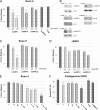A disease-associated polymorphism alters splicing of the human CD45 phosphatase gene by disrupting combinatorial repression by heterogeneous nuclear ribonucleoproteins (hnRNPs)
- PMID: 21507955
- PMCID: PMC3103377
- DOI: 10.1074/jbc.M111.218727
A disease-associated polymorphism alters splicing of the human CD45 phosphatase gene by disrupting combinatorial repression by heterogeneous nuclear ribonucleoproteins (hnRNPs)
Abstract
Alternative splicing is typically controlled by complexes of regulatory proteins that bind to sequences within or flanking variable exons. The identification of regulatory sequence motifs and the characterization of sequence motifs bound by splicing regulatory proteins have been essential to predicting splicing regulation. The activation-responsive sequence (ARS) motif has previously been identified in several exons that undergo changes in splicing upon T cell activation. hnRNP L binds to this ARS motif and regulates ARS-containing exons; however, hnRNP L does not function alone. Interestingly, the proteins that bind together with hnRNP L differ for different exons that contain the ARS core motif. Here we undertake a systematic mutational analysis of the best characterized context of the ARS motif, namely the ESS1 sequence from CD45 exon 4, to understand the determinants of binding specificity among the components of the ESS1 regulatory complex and the relationship between protein binding and function. We demonstrate that different mutations within the ARS motif affect specific aspects of regulatory function and disrupt the binding of distinct proteins. Most notably, we demonstrate that the C77G polymorphism, which correlates with autoimmune disease susceptibility in humans, disrupts exon silencing by preventing the redundant activity of hnRNPs K and E2 to compensate for the weakened function of hnRNP L. Therefore, these studies provide an important example of the functional relevance of combinatorial function in splicing regulation and suggest that additional polymorphisms may similarly disrupt function of the ESS1 silencer.
Figures







Similar articles
-
A cell-based screen for splicing regulators identifies hnRNP LL as a distinct signal-induced repressor of CD45 variable exon 4.RNA. 2008 Oct;14(10):2038-49. doi: 10.1261/rna.1212008. Epub 2008 Aug 21. RNA. 2008. PMID: 18719244 Free PMC article.
-
HnRNP L represses exon splicing via a regulated exonic splicing silencer.EMBO J. 2005 Aug 3;24(15):2792-802. doi: 10.1038/sj.emboj.7600745. Epub 2005 Jul 7. EMBO J. 2005. PMID: 16001081 Free PMC article.
-
A CD45 polymorphism associated with multiple sclerosis disrupts an exonic splicing silencer.J Biol Chem. 2001 Jun 29;276(26):24341-7. doi: 10.1074/jbc.M102175200. Epub 2001 Apr 16. J Biol Chem. 2001. PMID: 11306584
-
Silencers regulate both constitutive and alternative splicing events in mammals.Cell Mol Life Sci. 2005 Jul;62(14):1579-604. doi: 10.1007/s00018-005-5030-6. Cell Mol Life Sci. 2005. PMID: 15905961 Free PMC article. Review.
-
Research Progress on the Structural and Functional Roles of hnRNPs in Muscle Development.Biomolecules. 2023 Sep 22;13(10):1434. doi: 10.3390/biom13101434. Biomolecules. 2023. PMID: 37892116 Free PMC article. Review.
Cited by
-
Exon size and sequence conservation improves identification of splice-altering nucleotides.RNA. 2019 Dec;25(12):1793-1805. doi: 10.1261/rna.070987.119. Epub 2019 Sep 25. RNA. 2019. PMID: 31554659 Free PMC article.
-
Minimal functional domains of paralogues hnRNP L and hnRNP LL exhibit mechanistic differences in exonic splicing repression.Biochem J. 2013 Jul 15;453(2):271-9. doi: 10.1042/BJ20130432. Biochem J. 2013. PMID: 23646903 Free PMC article.
-
Starvation actively inhibits splicing of glucose-6-phosphate dehydrogenase mRNA via a bifunctional ESE/ESS element bound by hnRNP K.Biochim Biophys Acta. 2013 Sep;1829(9):905-15. doi: 10.1016/j.bbagrm.2013.04.009. Epub 2013 Apr 28. Biochim Biophys Acta. 2013. PMID: 23631859 Free PMC article.
-
Alternative splicing and cancer: insights, opportunities, and challenges from an expanding view of the transcriptome.Genes Dev. 2020 Aug 1;34(15-16):1005-1016. doi: 10.1101/gad.338962.120. Genes Dev. 2020. PMID: 32747477 Free PMC article. Review.
-
Control of alternative splicing in immune responses: many regulators, many predictions, much still to learn.Immunol Rev. 2013 May;253(1):216-36. doi: 10.1111/imr.12047. Immunol Rev. 2013. PMID: 23550649 Free PMC article. Review.
References
Publication types
MeSH terms
Substances
Grants and funding
LinkOut - more resources
Full Text Sources
Other Literature Sources
Medical
Research Materials
Miscellaneous

